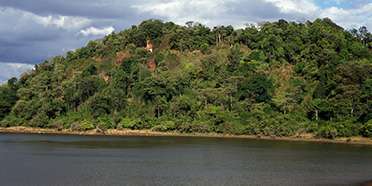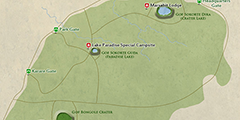- You are here:
- Home
- Countries & Parks
- Kenya Parks
- Marsabit National Park
Overview – Marsabit NP

Philip is a renowned Africa expert and author of many guidebooks to African destinations, including the DK Eyewitness Guide to Kenya.
Philip is an expert for SafariBookings and author of the DK Eyewitness Guide to Kenya.
Philip is the author of the DK Eyewitness Guide to Kenya.
Marsabit National Park lies in northern Kenya, an arid part of the country that tends to appeal mainly to adventurous travelers. It protects Mt Marsabit, a massive extinct volcano whose densely forested slopes stand in lush contrast to the thirsty scrubland that surrounds it. Bordered by Marsabit town, the park contains two gorgeous forest-fringed crater lakes that frequently attract elephant and buffalo herds.


Pros & Cons
- Untouristy and little-visited
- Beautiful crater lakes in dense forest
- Regularly seen wildlife includes buffalo and elephant, with the latter famed for their large tusks
- Good birding
- Simple guesthouse accommodations and camping only
- The road circuit is limited and ideally requires a high-clearance 4x4 vehicle
- Hot climate
- Encroachment in the south
Marsabit NP Safari Reviews
Wildlife
The dense forest and limited road circuit makes for challenging wildlife viewing. Elephants and buffalo are quite often seen around the crater lakes. Other forest-dwelling wildlife includes olive baboon, bushbuck, greater kudu and a few secretive leopards. Lion, cheetah, reticulated giraffe and Grevy’s zebra are resident on (or occasional visitors to) the more arid southern footslopes, along with various dry-country antelope.
Scenery
Densely forested Mt Marsabit is a fine example of a basaltic shield volcano. The slopes are peppered with extinct volcanic craters, known as gofs (the name used by the local Borana people). These include forested Gof Sokorte Dika and Gof Sokorte Guda (also known as Lake Paradise), both of which enclose near-permanent crater lakes. Much larger than either of these is Gof Bongole, which stands on the drier southern footslopes and also sometimes hosts a crater lake.
Activities
Game drives are most productive in the late afternoon, when elephant and buffalo most often drink at Gof Sokorte Dika and Guda. For the intrepid, a rough 4x4 road leads south from Gof Sokorte Guda to the arid country around Gof Bongole. Unguided walking is forbidden, but armed rangers may be available to lead a guided walk around one or both lakes. A small cultural museum stands at the main park entrance.
Weather & Climate
The park’s mountainous nature means there’s a lot of variation in altitude. Temperatures tend to be cooler as you go higher up the slopes. Generally, though, it stays hot during the day. This is certainly true in the Dry season (June to September) and even more so in the heart of the Wet season (October to May). Nights are more comfortably cool.
Best Time To Visit
To see animals out in the open, visit in the drier months when wildlife is most likely to visit the crater lakes. The best months for wildlife viewing are from June to September and January to February. Animals roam more widely (and often beyond the park) when it is wet, and those that stay can easily disappear into the dense vegetation. So, the wetter months (October to December and March to May) are not the best times to visit, unless birds are your priority.
Want To Visit Marsabit NP?
Marsabit NP Safari Reviews
- Expert Rating
- Wildlife
- Scenery
- Bush Vibe
- Birding
- User Rating
- Wildlife
- Scenery
- Bush Vibe
- Birding
Most Helpful Expert Review

Stuart is a travel writer and author of numerous Lonely Planet guidebooks, including 'Kenya', 'Rwanda' and 'Tanzania'.
Island in the Sky
Even with the new tarmac road that currently extends halfway to Marsabit from Isiolo and the Samburu National Reserve area, travelling to Marsabit, in the far north of Kenya, is a long, bumpy and hot bounce through semi-desert acacia scrub...


 Kenya Parks
Kenya Parks

